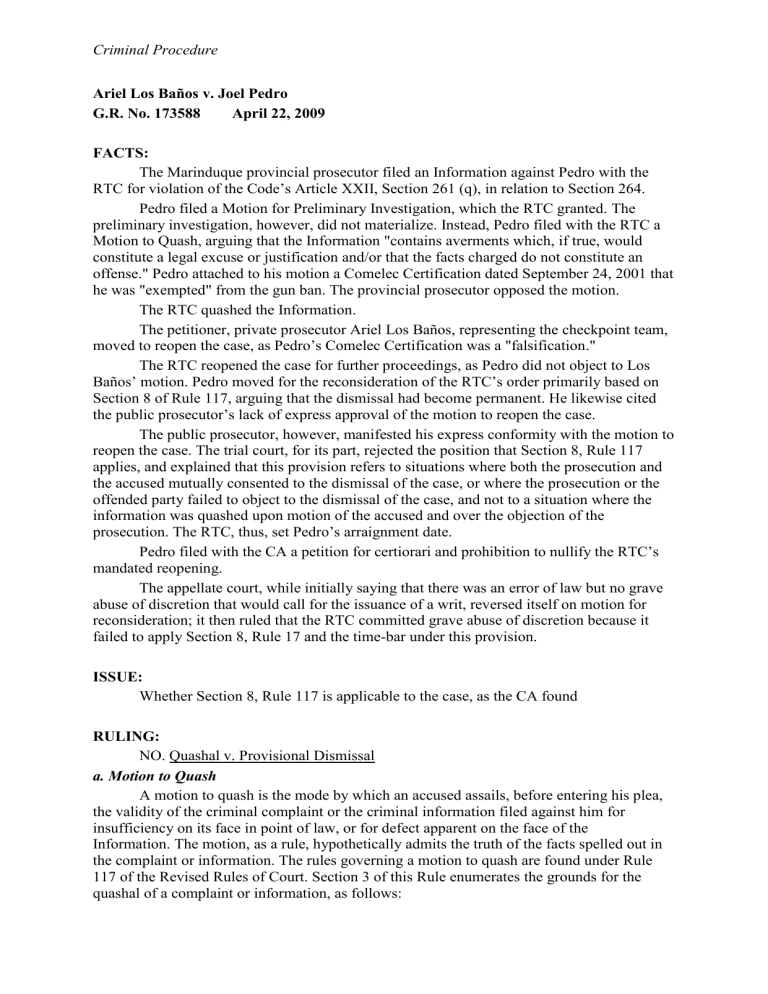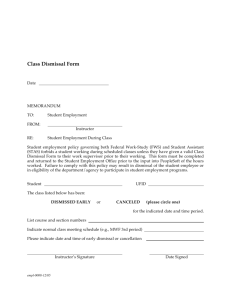
Criminal Procedure Ariel Los Baños v. Joel Pedro G.R. No. 173588 April 22, 2009 FACTS: The Marinduque provincial prosecutor filed an Information against Pedro with the RTC for violation of the Code’s Article XXII, Section 261 (q), in relation to Section 264. Pedro filed a Motion for Preliminary Investigation, which the RTC granted. The preliminary investigation, however, did not materialize. Instead, Pedro filed with the RTC a Motion to Quash, arguing that the Information "contains averments which, if true, would constitute a legal excuse or justification and/or that the facts charged do not constitute an offense." Pedro attached to his motion a Comelec Certification dated September 24, 2001 that he was "exempted" from the gun ban. The provincial prosecutor opposed the motion. The RTC quashed the Information. The petitioner, private prosecutor Ariel Los Baños, representing the checkpoint team, moved to reopen the case, as Pedro’s Comelec Certification was a "falsification." The RTC reopened the case for further proceedings, as Pedro did not object to Los Baños’ motion. Pedro moved for the reconsideration of the RTC’s order primarily based on Section 8 of Rule 117, arguing that the dismissal had become permanent. He likewise cited the public prosecutor’s lack of express approval of the motion to reopen the case. The public prosecutor, however, manifested his express conformity with the motion to reopen the case. The trial court, for its part, rejected the position that Section 8, Rule 117 applies, and explained that this provision refers to situations where both the prosecution and the accused mutually consented to the dismissal of the case, or where the prosecution or the offended party failed to object to the dismissal of the case, and not to a situation where the information was quashed upon motion of the accused and over the objection of the prosecution. The RTC, thus, set Pedro’s arraignment date. Pedro filed with the CA a petition for certiorari and prohibition to nullify the RTC’s mandated reopening. The appellate court, while initially saying that there was an error of law but no grave abuse of discretion that would call for the issuance of a writ, reversed itself on motion for reconsideration; it then ruled that the RTC committed grave abuse of discretion because it failed to apply Section 8, Rule 17 and the time-bar under this provision. ISSUE: Whether Section 8, Rule 117 is applicable to the case, as the CA found RULING: NO. Quashal v. Provisional Dismissal a. Motion to Quash A motion to quash is the mode by which an accused assails, before entering his plea, the validity of the criminal complaint or the criminal information filed against him for insufficiency on its face in point of law, or for defect apparent on the face of the Information. The motion, as a rule, hypothetically admits the truth of the facts spelled out in the complaint or information. The rules governing a motion to quash are found under Rule 117 of the Revised Rules of Court. Section 3 of this Rule enumerates the grounds for the quashal of a complaint or information, as follows: Criminal Procedure (a) That the facts charged do not constitute an offense; (b) That the court trying the case has no jurisdiction over the offense charged; (c) That the court trying the case has no jurisdiction over the person of the accused; (d) That the officer who filed the information had no authority to do so; (e) That it does not conform substantially to the prescribed form; (f) That more than one offense is charged except when a single punishment for various offenses is prescribed by law; (g) That the criminal action or liability has been extinguished; (h) That it contains averments which, if true, would constitute a legal excuse or justification; and (i) That the accused has been previously convicted or acquitted of the offense charged, or the case against him was dismissed or otherwise terminated without his express consent. b. Provisional Dismissal On the other hand, Section 8, Rule 117 that is at the center of the dispute states that: SEC.8. Provisional dismissal. — A case shall not be provisionally dismissed except with the express consent of the accused and with notice to the offended party. The provisional dismissal of offenses punishable by imprisonment not exceeding six (6) years or a fine of any amount, or both, shall become permanent one (1) year after issuance of the order without the case having been revived. With respect to offenses punishable by imprisonment of more than six (6) years, their provisional dismissal shall become permanent two (2) years after issuance of the order without the case having been revived. A case is provisionally dismissed if the following requirements concur: 1) the prosecution with the express conformity of the accused, or the accused, moves for a provisional dismissal (sin perjuicio) of his case; or both the prosecution and the accused move for its provisional dismissal; 2) the offended party is notified of the motion for a provisional dismissal of the case; 3) the court issues an order granting the motion and dismissing the case provisionally; and 4) the public prosecutor is served with a copy of the order of provisional dismissal of the case. In People v. Lacson, we ruled that there are sine quanon requirements in the application of the time-bar rule stated in the second paragraph of Section 8 of Rule 117. We also ruled that the time-bar under the foregoing provision is a special procedural limitation qualifying the right of the State to prosecute, making the time-bar an essence of the given right or as an inherent part thereof, so that the lapse of the time-bar operates to extinguish the right of the State to prosecute the accused. c. Their Comparison An examination of the whole Rule tells us that a dismissal based on a motion to quash and a provisional dismissal are far different from one another as concepts, in their features, and legal consequences. While the provision on provisional dismissal is found within Rule Criminal Procedure 117 (entitled Motion to Quash), it does not follow that a motion to quash results in a provisional dismissal to which Section 8, Rule 117 applies. A first notable feature of Section 8, Rule 117 is that it does not exactly state what a provisional dismissal is. The modifier "provisional" directly suggests that the dismissals which Section 8 essentially refers to are those that are temporary in character (i.e., to dismissals that are without prejudice to the re-filing of the case), and not the dismissals that are permanent (i.e., those that bar the re-filing of the case). Based on the law, rules, and jurisprudence, permanent dismissals are those barred by the principle of double jeopardy, by the previous extinction of criminal liability, by the rule on speedy trial, and the dismissals after plea without the express consent of the accused. Section 8, by its own terms, cannot cover these dismissals because they are not provisional. A second feature is that Section 8 does not state the grounds that lead to a provisional dismissal. This is in marked contrast with a motion to quash whose grounds are specified under Section 3. The delimitation of the grounds available in a motion to quash suggests that a motion to quash is a class in itself, with specific and closely-defined characteristics under the Rules of Court. A necessary consequence is that where the grounds cited are those listed under Section 3, then the appropriate remedy is to file a motion to quash, not any other remedy. Conversely, where a ground does not appear under Section 3, then a motion to quash is not a proper remedy. A motion for provisional dismissal may then apply if the conditions required by Section 8 obtain. A third feature, closely related to the second, focuses on the consequences of a meritorious motion to quash. This feature also answers the question of whether the quashal of an information can be treated as a provisional dismissal. Sections 4, 5, 6, and 7 of Rule 117 unmistakably provide for the consequences of a meritorious motion to quash. Section 4 speaks of an amendment of the complaint or information, if the motion to quash relates to a defect curable by amendment. Section 5 dwells on the effect of sustaining the motion to quash - the complaint or information may be re-filed, except for the instances mentioned under Section 6. The latter section, on the other hand, specifies the limit of the re-filing that Section 5 allows – it cannot be done where the dismissal is based on extinction of criminal liability or double jeopardy. Section 7 defines double jeopardy and complements the ground provided under Section 3(i) and the exception stated in Section 6. Rather than going into specifics, Section 8 simply states when a provisional dismissal can be made, i.e., when the accused expressly consents and the offended party is given notice. The consent of the accused to a dismissal relates directly to what Section 3(i) and Section 7 provide, i.e., the conditions for dismissals that lead to double jeopardy. This immediately suggests that a dismissal under Section 8 – i.e., one with the express consent of the accused – is not intended to lead to double jeopardy as provided under Section 7, but nevertheless creates a bar to further prosecution under the special terms of Section 8. This feature must be read with Section 6 which provides for the effects of sustaining a motion to quash – the dismissal is not a bar to another prosecution for the same offense – unless the basis for the dismissal is the extinction of criminal liability and double jeopardy. These unique terms, read in relation with Sections 3(i) and 7 and compared with the consequences of Section 8, carry unavoidable implications that cannot but lead to distinctions between a quashal and a provisional dismissal under Section 8. They stress in no uncertain terms that, save only for what has been provided under Sections 4 and 5, the governing rule when a motion to quash is meritorious are the terms of Section 6. The failure of the Rules to state under Section 6 that a Section 8 provisional dismissal is a bar to further prosecution shows that the framers did not intend a dismissal based on a motion to quash and a provisional dismissal to be confused with one another; Section 8 operates in a world of its Criminal Procedure own separate from motion to quash, and merely provides a time-bar that uniquely applies to dismissals other than those grounded on Section 3. Conversely, when a dismissal is pursuant to a motion to quash under Section 3, Section 8 and its time-bar does not apply. Other than the above, we note also the following differences stressing that a motion to quash and its resulting dismissal is a unique class that should not be confused with other dismissals: First, a motion to quash is invariably filed by the accused to question the efficacy of the complaint or information filed against him or her (Sections 1 and 2, Rule 117); in contrast, a case may be provisionally dismissed at the instance of either the prosecution or the accused, or both, subject to the conditions enumerated under Section 8, Rule 117. Second, the form and content of a motion to quash are as stated under Section 2 of Rule 117; these requirements do not apply to a provisional dismissal. Third, a motion to quash assails the validity of the criminal complaint or the criminal information for defects or defenses apparent on face of the information; a provisional dismissal may be grounded on reasons other than the defects found in the information. Fourth, a motion to quash is allowed before the arraignment (Section 1, Rule 117); there may be a provisional dismissal of the case even when the trial proper of the case is already underway provided that the required consents are present.27 Fifth, a provisional dismissal is, by its own terms, impermanent until the timebar applies, at which time it becomes a permanent dismissal. In contrast, an information that is quashed stays quashed until revived; the grant of a motion to quash does not per se carry any connotation of impermanence, and becomes so only as provided by law or by the Rules. In re-filing the case, what is important is the question of whether the action can still be brought, i.e., whether the prescription of action or of the offense has set in. In a provisional dismissal, there can be no re-filing after the time-bar, and prescription is not an immediate consideration. To recapitulate, quashal and provisional dismissal are different concepts whose respective rules refer to different situations that should not be confused with one another. If the problem relates to an intrinsic or extrinsic deficiency of the complaint or information, as shown on its face, the remedy is a motion to quash under the terms of Section 3, Rule 117. All other reasons for seeking the dismissal of the complaint or information, before arraignment and under the circumstances outlined in Section 8, fall under provisional dismissal. Thus, we conclude that Section 8, Rule 117 does not apply to the reopening of the case that the RTC ordered and which the CA reversed; the reversal of the CA’s order is legally proper.

